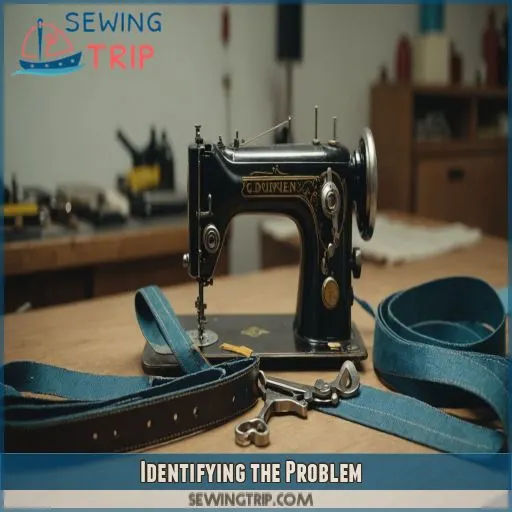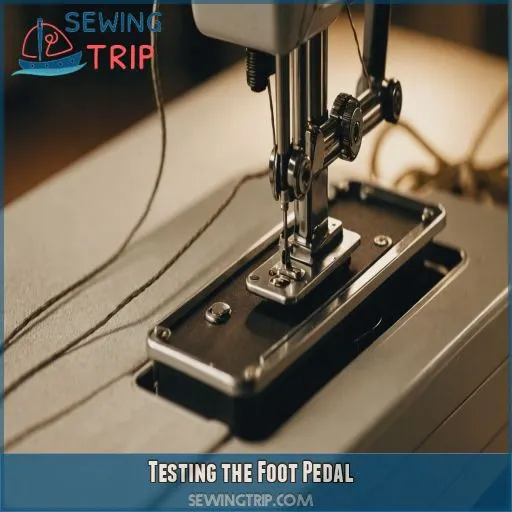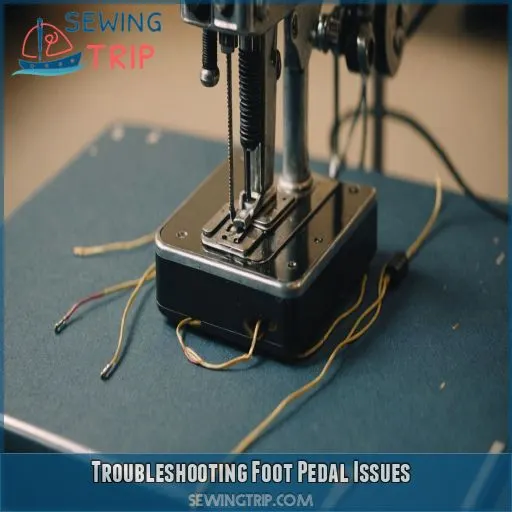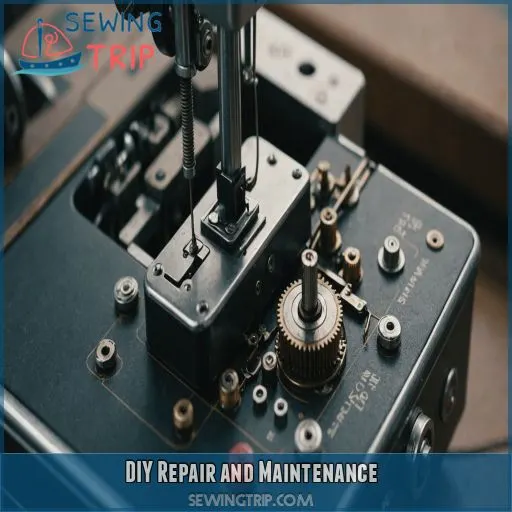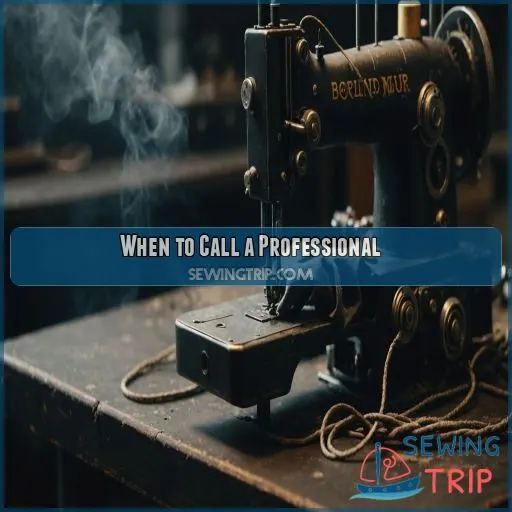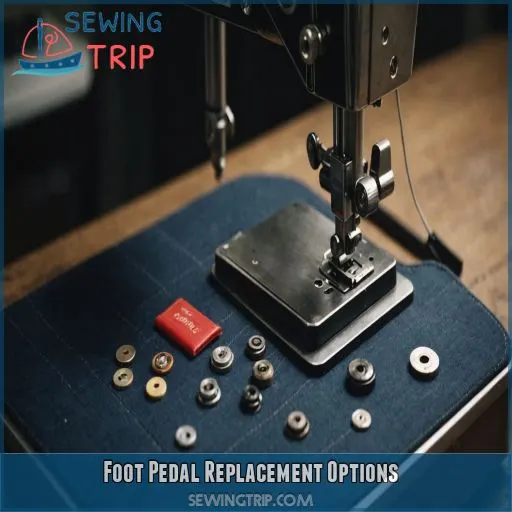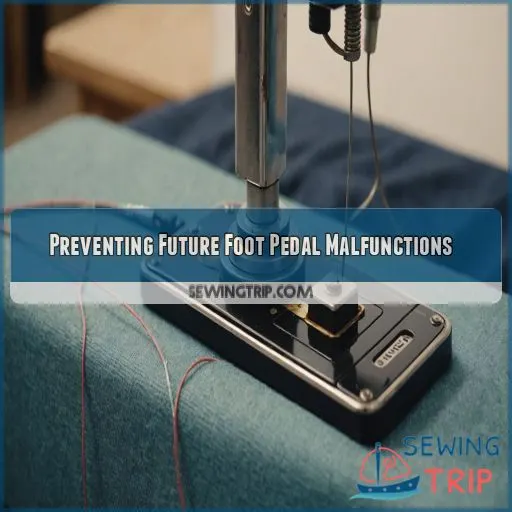This site is supported by our readers. We may earn a commission, at no cost to you, if you purchase through links.
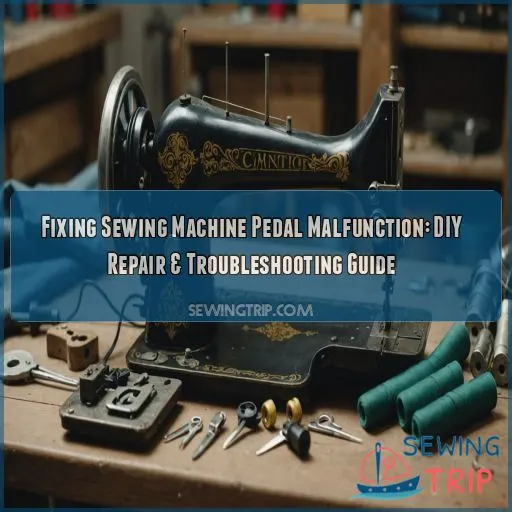
First, let’s identify the problem – is it a worn-out part, power issue, or dirty contact? Check your pedal connection, cord integrity, and power source.
If that doesn’t work, it’s time to get a little more invasive. You might need to disassemble the pedal or replace a faulty cord.
But don’t worry, with a little patience and elbow grease, you’ll be sewing like a pro in no time.
Table Of Contents
Key Takeaways
- Don’t freak out if your trusty sewing machine pedal stops working – you can repair it with some DIY know-how and troubleshooting. Start by checking the connection, cord integrity, and power source to identify the problem.
- You can test your foot pedal by plugging it in, pressing down gently, and listening for a humming or buzzing sound. If it’s quiet, it might be the culprit behind your sewing machine woes.
- Regular cleaning and maintenance can go a long way in preventing future malfunctions. Set up a schedule to clean the pedal every 3-6 months, and inspect it for wear and tear. Check cords for frays and replace them if needed.
- If all else fails, it might be time to call a professional or consider upgrading to a new sewing machine model. Weigh the costs, explore trade-in options, and compare models to find your perfect match – your future self (and your projects) will thank you!
Identifying the Problem
You’re probably frustrated if your trusty sewing machine pedal has stopped working, and who can blame you – it’s a key part of your sewing setup. To get back to stitching smoothly, let’s first figure out what’s gone wrong with your pedal, whether it’s a common issue, a Bernina-specific problem, or something else entirely.
Common Causes of Foot Pedal Malfunction
Let’s get your sewing machine pedal up and running. Common causes of pedal malfunction include worn-out parts, power issues, damaged cords, dirty contacts, and loose connections. Check your pedal’s cord for any signs of damage or fraying. Make sure it’s securely plugged in, and that the power is on. A simple fix might be all you need.
Symptoms of a Faulty Foot Pedal
Now that we’ve covered the common causes of foot pedal malfunction, let’s talk about the symptoms. You know your foot pedal is faulty when:
- Your sewing machine speed control goes haywire, and you get erratic stitching.
- The pedal is stuck, or it doesn’t respond to pressure.
- You get no power when you press the pedal.
- The speed is inconsistent, making it hard to get a smooth stitch.
Bernina Sewing Machine Specific Issues
If you’re a Bernina sewing machine owner, you might encounter specific pedal issues.
Check your Bernina pedal compatibility and wiring to make sure you have a smooth connection.
For troubleshooting, refer to your user manual or online resources.
If the issue persists, consider Bernina pedal replacement or repair.
Don’t worry, with the right guidance, you’ll be sewing like a pro in no time!
General Sewing Machine Pedal Problems
You’re dealing with a finicky sewing machine pedal.
Don’t worry, it’s not you, it’s the pedal!
Common issues include faulty connections, worn-out parts, and compatibility problems.
Look for signs of wear like frayed cords or rusty hinges.
Regular cleaning and troubleshooting can help, but if all else fails, consider replacing the pedal – it’s worth the cost for a stress-free sewing experience!
Testing the Foot Pedal
Now that you’ve pinpointed the problem, it’s time to roll up your sleeves and test that foot pedal. You’ll be checking connections and power sources to make sure everything is working properly before moving on to the next steps.
Step-by-Step Guide to Testing the Foot Pedal
Now that you know the common problems, let’s get that pedal back in tip-top shape with some testing:
- First things first: unplug the foot pedal from the machine.
- Check the cord integrity. Look for any visible signs of damage, like fraying, cuts, or exposed wires.
How to Check the Pedal Connection
A wonky connection between your pedal and machine can lead to all sorts of mischief.
First, check that the pedal fits snugly into your sewing machine.
A loose connection can cause all kinds of chaos.
If it’s secure, move on to inspecting the wiring.
Look for any loose connections or signs of damage.
Frayed or exposed wires are a sure sign something’s amiss.
Verifying Power Source and Cord Integrity
Now that you’ve checked the pedal connection, it’s time to verify the power source and cord integrity. Confirm the outlet is working by plugging in another device. Inspect the cord for damage, such as frays, cuts, or burn marks. Check for voltage drop issues or electrical surges that might be affecting your sewing machine’s performance.
- A damaged cord can be a fire hazard, so don’t ignore those frays!
- A faulty power outlet can cause your machine to malfunction or not turn on at all
- Voltage drop issues can lead to inconsistent stitching and damage to your machine’s motor
- Electrical surges can fry your machine’s electronics, so consider investing in a surge protector
- Regularly inspecting your cord and power source can save you from costly repairs down the line
Troubleshooting Foot Pedal Issues
You’re about to tackle the frustrating world of foot pedal malfunctions, but don’t worry, with these troubleshooting steps, you’ll be sewing like a pro in no time. Let’s get started with the basics: ensuring proper connection and fit, replacing damaged or faulty cords, addressing pedal damage and wear, and resolving internal malfunctions and compatibility issues.
Ensuring Proper Connection and Fit
Now that you’ve tested your foot pedal, it’s time to verify a proper connection and fit. Check the pedal socket for any debris or corrosion. Make sure the pedal is securely plugged in, with a stable connection. Inspect the terminal for any signs of wear. A secure fit is key to smooth stitching, so don’t overlook this vital step.
Replacing Damaged or Faulty Cords
If you’ve identified cord damage, don’t worry, it’s an easy fix.
Check your sewing machine manual for cord replacement costs and instructions.
To prevent future damage, keep cords tidy, avoid pinching or bending, and store them safely.
Regularly inspect cords for frays, cuts, or signs of wear, and replace them promptly to avoid further issues.
Addressing Pedal Damage and Wear
Time to tackle that worn-out pedal. Inspect it for cracks, dents, or worn-down parts. If it’s damaged, weigh the costs of repair versus replacement. Consider DIY repair tips or consult a pro if needed. Regular maintenance routines can help prevent future breakage. Take charge and get your pedal back in working order – your sewing sanity will thank you!
Resolving Internal Malfunctions and Compatibility Issues
Now that you’ve addressed pedal damage and wear, it’s time to tackle internal malfunctions and compatibility issues. Don’t worry, it’s not as scary as it sounds! If you’re not comfortable with DIY repairs, it’s best to seek professional help. Here are some options to keep in mind:
- Check your manufacturer’s support resources for internal diagnostics and repair guides.
- Research pedal compatibility to make sure you’re using the right one for your machine.
- Weigh the costs and benefits of DIY vs. professional repair – sometimes it’s better to leave it to the experts!
DIY Repair and Maintenance
You’re about to get hands-on and fix that faulty foot pedal – and with these DIY repair and maintenance tips, you’ll be back to sewing like a pro in no time. By disassembling, diagnosing, cleaning, and replacing worn-out parts, you’ll save money but also develop a deeper understanding of your trusty sewing machine’s inner workings.
Disassembling and Diagnosing the Foot Pedal
Time to get up close and personal with your foot pedal’s inner workings! To disassemble, you’ll need a screwdriver and some caution. Remove any visible screws, taking note of the parts and their placement. As you expose the pedal’s guts, inspect for worn-out or damaged components. Check for loose connections, corrosion, or blockages that might be causing the malfunction.
Cleaning and Lubricating Foot Pedal Components
- Soft brush: Gently sweep away dust and debris.
- Canned air: Blast away any remaining dust bunnies.
- Mild soap: Clean any stubborn stains or grime.
- Silicone-based lubricant: Keep those moving parts smooth and happy.
Replacing Worn-Out or Damaged Parts
Time to get hands-on! When replacing worn-out or damaged parts, source them from authorized dealers or online marketplaces. Compare prices to make sure you’re getting the best deal. Consider DIY repair kits, which often include replacement parts and step-by-step instructions. Remember, replacing parts can be cost-effective and empowering – you’re one step closer to mastering your sewing machine!
Tips for Preventing Future Malfunctions
To prevent future malfunctions, take care of your foot pedal. Regular cleaning and inspection can go a long way. Develop good habits, like storing the pedal properly and avoiding cord tangles. You’ll be sewing like a pro in no time. Here are some tips to keep your foot pedal in top shape:
- Clean the pedal regularly with a soft brush or cloth
- Store the pedal in a dry, cool place, away from direct sunlight
- Keep cords organized and untangled to prevent damage
- Avoid exposing the pedal to extreme temperatures or moisture
- Use a surge protector to safeguard against power surges and spikes
When to Call a Professional
You’ve tried troubleshooting your sewing machine pedal, but it still refuses to cooperate – it’s time to know when to throw in the towel and call a professional. Knowing when to seek expert help can save you from further frustration and potentially causing more damage to your machine.
Recognizing the Need for Expert Help
You’ve tried everything, but your sewing machine pedal still won’t behave. If you notice a burnt smell, unusual noises, or the pedal doesn’t respond, it’s time to call in the experts. Inconsistent stitching can also be a sign of a deeper issue. Don’t worry, knowing when to ask for help is a sign of sewing mastery, not defeat!
Finding a Qualified Sewing Machine Technician
You’ve decided to call in the pros. Now, where to find them? Look for technicians with experience in sewing machine repair and certifications from reputable organizations. Here are some tips to help you find the right one:
- Check online reviews from sites like Yelp or Google to see what other customers have to say.
- Ask around at local repair shops or sewing machine dealerships for recommendations.
- Compare the technician’s experience and certifications to make sure you’re getting the best service.
Understanding the Costs and Benefits of Professional Repair
Now that you’ve decided to call a pro, let’s talk turkey. What’s the repair cost? Is your machine still under warranty? Consider the expertise and time required to fix the issue. Weigh the pros and cons of DIY vs. pro repair, especially if your machine is old.
| Factor | Consideration |
|---|---|
| Repair Cost | $50-$200, depending on the issue |
| Warranty | Check if your machine is still covered |
| Expertise | Pros have the skills and knowledge to fix it right |
Foot Pedal Replacement Options
You’ve tried troubleshooting and DIY repairs, but it’s time to face the music: your trusty foot pedal needs to be replaced. Don’t worry, you’ve got options – from purchasing a shiny new compatible pedal to exploring alternative designs or adapting a different model, and even tapping into the collective wisdom of sewing machine communities and forums.
Purchasing a New Compatible Foot Pedal
If calling a professional isn’t your thing, purchasing a new compatible foot pedal is the way to go. Double-check compatibility by looking at your sewing machine’s manual or manufacturer’s website. Here are some emotional considerations to keep in mind:
- You’ll finally be able to finish that project you’ve been putting off
- No more frustrating hours spent troubleshooting
- Your wallet might take a hit, but think of all the stress you’ll avoid
- A shiny new pedal can give you a sense of excitement and renewal
Exploring Alternative Foot Pedal Designs
Ready to break free from traditional foot pedals? Explore alternative designs that put you in control!
Ergonomic designs reduce fatigue, while pedal customization lets you tailor the feel to your sewing style.
Wireless options offer freedom from cords, and various foot control types cater to different needs.
Plus, pedal materials like durable plastics or metals mean they’ll last for years and years of sewing adventures.
Adapting a Different Foot Pedal Model
Time to get creative with foot pedal adaptations. If you can’t find an exact replacement, consider modifying a different model to fit your sewing machine. Here are three things to keep in mind:
- Check compatibility: Make sure the new pedal’s wiring and connector type match your machine’s requirements.
- Make wiring adjustments: Be prepared to tweak the wiring to get everything working smoothly.
- Research alternative brands: Look into other brands offering compatible pedals or DIY modification options.
Joining Sewing Machine Communities and Forums
Joining sewing machine communities and forums can be a lifesaver when dealing with pedal malfunctions. You’ll find fellow sewers who’ve been in your shoes, sharing their troubleshooting tips and experiences.
| Community | Benefits |
|---|---|
| Sewing Parts Online Forum | Expert advice, parts sourcing |
| Sewing Machine subreddit | Community support, DIY tutorials |
| Sew Over It | Pattern sharing, project inspiration |
Preventing Future Foot Pedal Malfunctions
You’ve finally fixed that finicky foot pedal, and now you want to make sure it stays that way.
A reliable sewing machine pedal is the secret to a stress-free stitching experience.
In this section, you’ll learn how to prevent future foot pedal malfunctions through regular maintenance, proper care, and knowing when it’s time to upgrade to a newer model.
Regular Maintenance and Inspection Schedule
Set up a regular maintenance schedule to keep your sewing machine pedal in top shape. Clean the pedal every 3-6 months, and inspect it for wear and tear. Check cords for frays and replace them if needed. Early detection can prevent malfunctions. Create a routine and stick to it – your pedal (and your sanity) will thank you!
Best Practices for Foot Pedal Care and Handling
Now that you’ve got a regular maintenance schedule down, let’s talk best practices for foot pedal care and handling. Store it safely, avoiding tangles and dust bunnies. Use proper techniques when sewing, keeping your foot gentle on the pedal. Clean it regularly, and always unplug before handling. Your pedal (and your projects) will thank you!
Upgrading to a New Sewing Machine Model
If your trusty old sewing machine is giving you more headaches than hemlines, consider trading up to a new model. You’ll get the latest sewing technology, improved performance, and fewer pedal problems. Weigh the costs, explore trade-in options, and compare models to find your perfect match. Your future self (and your projects) will thank you!
Frequently Asked Questions (FAQs)
Why isn’t the foot pedal on my sewing machine working?
If your sewing machine’s foot pedal isn’t working, check the connection first – is it plugged in securely? Then, inspect the cord for damage and verify the power source is working properly.
How do you test a sewing machine foot pedal?
Think of your sewing machine foot pedal as a trusty dance partner – it needs to be in sync with you! To test it, plug it in, press the pedal, and listen for a gentle humming sound, indicating it’s working.
How do I stop my sewing machine pedal from moving?
To stop your sewing machine pedal from moving, try adjusting the pedal’s position to reduce slipping, or place a non-slip mat under it. You can also use a pedal stop or anchor it with adhesive-backed Velcro.
How to test foot pedal?
Time to get your pedal in check! To test your foot pedal, simply plug it in, press down gently, and listen for a humming or buzzing sound – if it’s quiet, it might be the culprit behind your sewing machine woes.
Can I use a generic pedal with my sewing machine?
Can you use a generic pedal with your sewing machine? Honestly, it’s a gamble. To avoid compatibility issues, it’s best to stick with a pedal specifically designed for your machine’s make and model.
How often should I clean the foot pedal connection area?
Clean the foot pedal connection area every 1-3 months or whenever you notice a buildup of dust and debris. A soft brush and dry cloth will do the trick – keep it tidy and your pedal will thank you!
Can a sewing machine pedal be repaired at home easily?
Taking the reins of repair, can you fix a sewing machine pedal at home? Absolutely! With basic DIY skills and patience, you can easily troubleshoot and repair common pedal issues, saving you time and money.
What is the average cost of a sewing machine pedal?
You’re likely wondering about the cost of a sewing machine pedal. On average, a replacement pedal can range from $20 to $100, depending on the brand, model, and features – a relatively small price for sewing freedom!
Can I use a sewing machine without a foot pedal?
You can use a sewing machine without a foot pedal by utilizing the machine’s built-in speed control or a hand-operated stitch regulator, but you’ll sacrifice some precision and control, making it less efficient and more tedious.
Conclusion
You’ve made it through the repair process. With these DIY troubleshooting tips, you’ve tackled that finicky sewing machine pedal malfunction like a pro.
Pat yourself on the back – repairing a sewing machine pedal malfunction is no small feat.
Now, get back to creating with confidence. Remember, a well-maintained pedal is a happy pedal.

